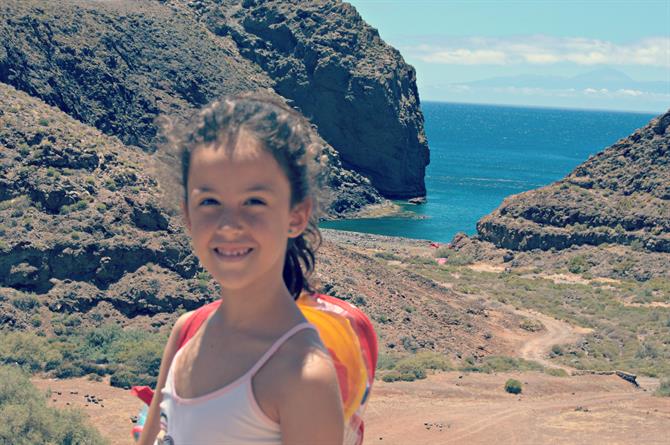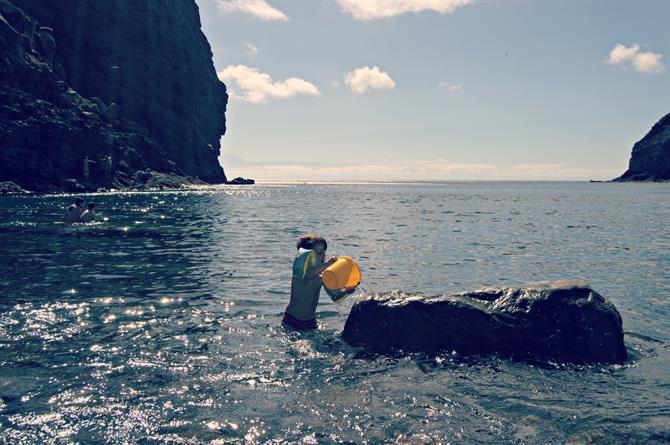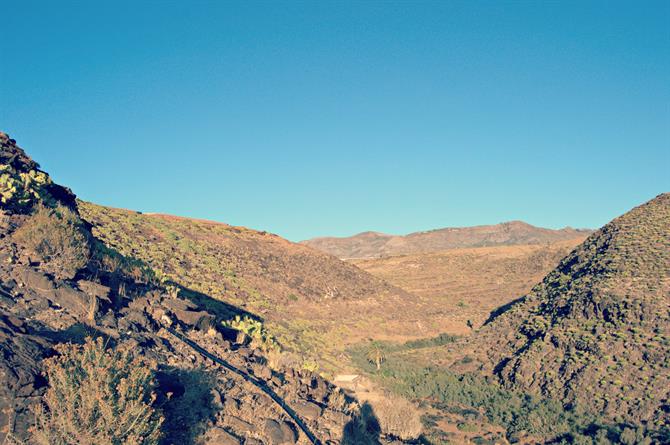Imagine a Gran Canaria beach, if you will. You're picturing vanilla sand, palm trees, and parasols, right? Sorry to shatter your daydream but El Juncal's not that beach. Nevertheless, it's pretty typical of the beaches in the north and west of the island which tend to be stony rather than sandy. And it's our family's vision of paradise.
Playa del Juncal: getting there

Forget Dora, this is Esther the Explorer aka Mini Monica because of her similarity to her mother of the same name. She's my niece who we were looking after as her parents were at a wedding. Here she is on our descent to Playa del Juncal.
But we're getting ahead of ourselves. We drove from our Las Palmas de Gran Canaria base along the GC-2 in the only direction available from there, west towards Agaete for around 30 minutes. Passing Gáldar's Cruz de Pineda, which if you're travelling by bus on Global's 103 you'll have to get out at, we took the next right turn. Signposted El Cardonal.
There followed a sharpish left. Now you continue straight past a row of greenhouses. Take the last left to follow what's become a dirt track to the first car park.
Playa del Juncal's two-story car park

Unless you're travelling in a 4x4, you're going to have to leave your wheels where the cars are parked in the picture above. From there, it's a 0.75km drop to the beach below. Bear in mind, however, that it's a winding, sometimes windy, path and you'll be walking between 10 and 15 minutes to reach your final destination.
When you get to the bottom, if you're travelling as a family like us, head to the left-hand side of the 120m-long beach. Here, the access to the water's easier. The right-hand side is rockier, which apparently attracts nudists. Although, I've yet to see any on each of my three visits to El Juncal.
Take a bath in the Atlantic

The waves are not particularly strong at Playa El Juncal. Which transforms the raging Atlantic Ocean into a giant bath, especially as the water temperature averages around 20 degrees centigrade. Here's our Tommy, water-winged up, and pouring water over a rock. Well, sandcastles were out of the question.
El Juncal was once a port. The wives of the fisherman who plundered the local waters used to join their husbands on the fishing boats. They'd then proceed to carry the catches of the day on their heads and walk up the ravine which leads down to the beach, so as to sell fresh fish to the locals.
Admire the view

There are some great views to be had at the Playa del Juncal. This photo was taken on the climb to the car park and is of the ravine from which the beach takes its name, the Barranco del Juncal. There's also plenty to see on the playa itself.
For a start, the water's some of the cleanest on the island and even without a mask, you'll be able to see fish swimming around your feet. In front of you, doing its Mount Fuji impression, is Tenerife's Teide. There are also vistas of Agaete's dramatic coastline. So, remember to bring your camera to record images of a beach less ordinary.
And to keep El Juncal clean and serene, take your rubbish away with you. It's impossible for the bin men to get to this beach. I did my bit, by chasing and catching a plastic bag that wasn't even ours, which we later recycled on our return to Las Palmas de Gran Canaria.
